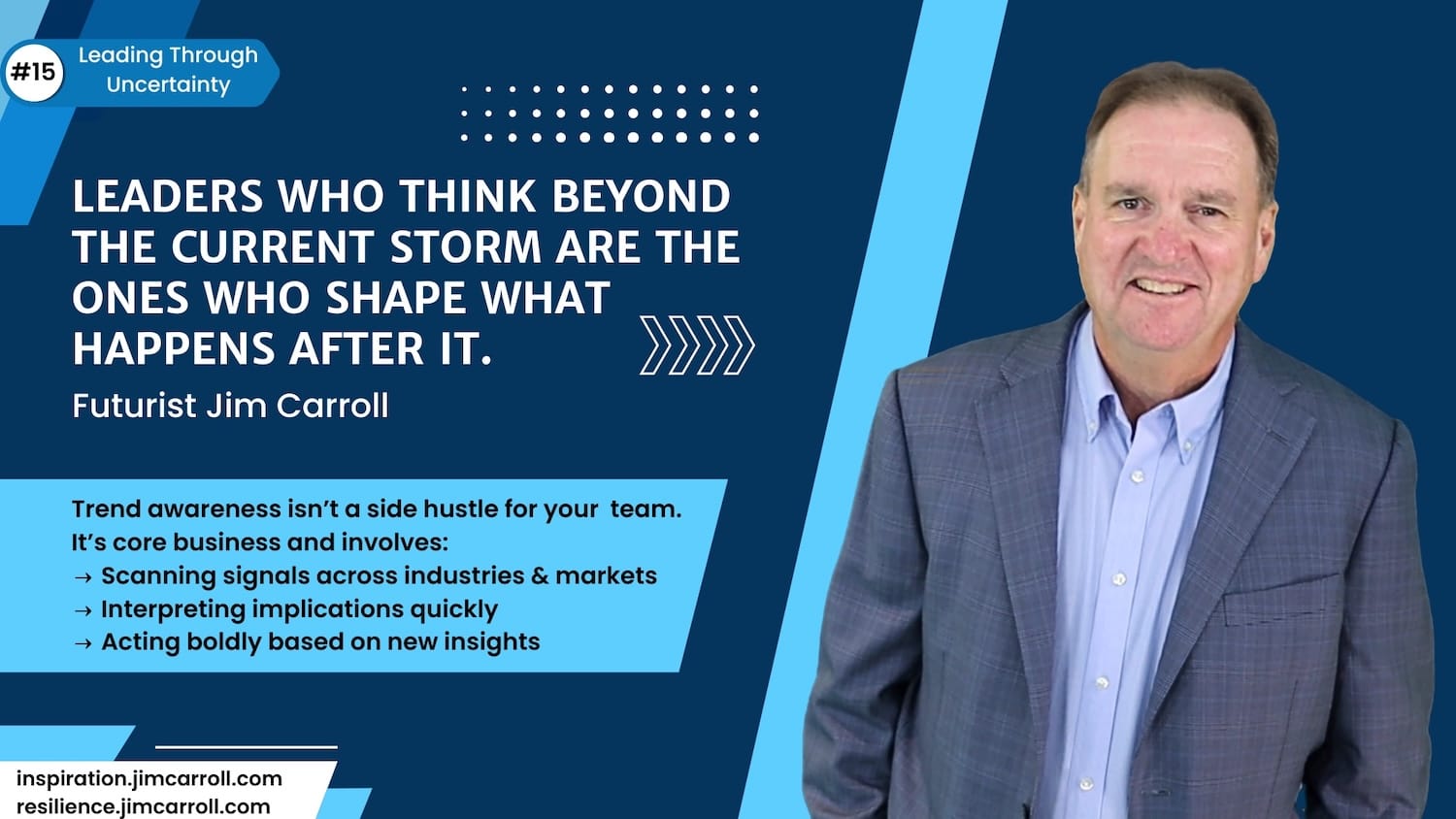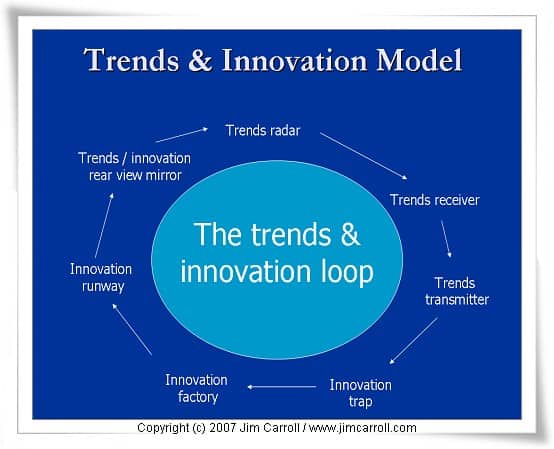"Leaders who think beyond the current storm are the ones who shape what happens after it." - Futurist Jim Carroll

I built a little website for the book this weekend. Have a peek - it's at dancing.jimcarroll.com! Over the years, I've found one of the best ways to finish an idea is to put a stake in the ground. The stake has been hammered in!

Here's a key thing to think about: strategic foresight always beats tactical firefighting.
The strongest organizations think beyond today’s chaos—and start building the world they want to lead. That's because they know that economic growth always follows the minds that create the ideas of tomorrow, and they know it's better to be one of those minds.
Most leaders and organizations don't do this though. It’s easy, in a time of volatility, to fall into survival mode. Watching the headlines, managing today’s problems, and delaying everything else. But if history teaches us anything, it's this: the companies that think beyond the current storm are the ones that shape what happens after it.
They don't just react to the present—they create the future. They subscribe to the most important statement about the future made by Bill Gates: "Most people tend to overestimate the rate of change on a two-year basis, but underestimate change on a ten-year basis." With that in mind, they know one of the most important things they need to be doing right now is to ensure they have a firm grasp of what comes tomorrow - and what they need to do about it.
Why does it matter? Leadership during uncertainty isn’t just about managing immediate fires. It’s about constantly asking: “What world will emerge next—and how do we lead it?” Forward-oriented thinking forces you to operate across two horizons: managing today’s pressures realistically, and strategizing tomorrow’s opportunities relentlessly. You can't do the latter if you don't have a firm grasp on what comes tomorrow.
McKinsey research shows that companies that allocate resources based on future trends—not just past results—outperform their industry peers by nearly 40% over 10 years. The fact is, short-term thinking Is a trap but sadly, it has become the norm. When volatility rises, leadership conversations shrink - from multi-year strategy to monthly budgets; from future innovation to weekly crisis meetings; from new market creation to operational firefighting; and from big, bold, long-term visions to small, narrow daily actions.
And the fact is, the longer you stay trapped today, the further you fall behind the leaders building tomorrow. The future doesn't slow down in a recession - it speeds up.
The future’s coming at us faster than ever before when uncertainty rages. Markets shift overnight. Customer expectations change in a heartbeat. Entire industries end up being reinvented while others quietly fade into history. You can’t afford to wait until the smoke clears. You’ve got to study what’s coming—and more importantly, act on it.
That reality doesn't go away in a downturn. This means keeping these realities in mind:
- Leadership sets the tone. If you're in any position of leadership, your job is crystal clear. You need to establish a culture that’s focused on the future. You’ve got to constantly connect today’s actions to tomorrow’s realities. If you’re not encouraging your team to move faster, think bigger, and adapt quicker, you’re holding them back. In a downturn, this means getting them out of their short-term funk into a longer-term mindset.
- Watching isn’t enough. A lot of people think that reading a few reports or attending a conference checks the box. It doesn’t. Observing trends is passive. Real leadership demands that you take those observations and turn them into actionable plans. Trend-watching without action is just glorified procrastination. Double down on that right now despite a lack of clarity.
- Innovation is the engine, but trends are the fuel. When I talk about studying the future, I’m always talking about innovation. The best innovators aren't just reacting to change. They’re anticipating it. They’re building for it. They’re using it as fuel. Innovation isn’t some big mysterious thing. It’s simply the act of responding intelligently and creatively to the trends shaping your world. And if the trends shaping your world are doing so in an uncertain way, you've gotta be prepared to fire up your creativity engine, in a way you might not have had before, because you now have to imagine what was once unimaginable.
- It’s not just about dodging disruption. Yes, the future brings threats. But it also brings opportunities—huge ones. The organizations and people who thrive are the ones who don't just try to defend against what’s coming. They lean into it. They find the openings others are too scared or too slow to see. And here's a fun fact - disruption doesn't disappear in a downturn. History is full of examples of companies that took advantage of the uncertainty to launch their bold idea, knowing that everyone was too busy panicking to watch what they were doing.
- The future isn’t a project - it’s a way of life. Studying future trends isn’t a “one-and-done” effort. You don’t build a strategy and walk away. You build a mindset. A daily habit. An organizational muscle that stays tuned to change, every single day. And that should not go away during a time of uncertainty.
Here’s the real takeaway: studying the future isn’t about predicting what’s going to happen. It’s about building the capability to respond faster, smarter, and more aggressively than everyone else. It’s about seeing what’s next before it hits and being ready when it does.
You can’t sit back and hope the future will be kind to you. You have to go out and shape it.
The companies that will dominate the next decade are already investing in new capabilities, technologies, markets, and ideas—even while today’s challenges are raging. That's why I always suggest that a recession or downturn is the best time for an organization to align to my Trends & Innovation Loop - something I outlined way back in 2007 as I saw the economic storm clouds gathering for what would become the great economic meltdown of 2008.

The process works like this:
- Scan emerging trends relentlessly - technology, customer behaviour, science, business models
- Anticipate disruptive shifts early. - spot cracks and emerging opportunities before they go mainstream
- Innovate intentionally - build offerings and strategies for the world that is coming, not the world that was.
- Accelerate learning and execution - prototype, refine, and scale based on what works.
- Repeat continuously - trend-watching and innovation aren’t one-time projects - they are permanent leadership disciplines.
Trend awareness Is a key leadership discipline that becomes more important in a time of uncertainty - and future-ready leadership demands building “trend radars” directly into the organization. That means formal mechanisms for scanning signals across industries and markets, interpreting the implications quickly, and acting boldly based on those insights. As I always like to say - trend awareness isn’t a side hustle for your innovation team. It’s core business. In today's economy, ignoring trends isn’t just risky - it’s fatal.
So what do you do? Make sure you have your team studying the things that matter. Build discussion of the future into every strategy meeting, even when you are firefighting. To define your actions, start with tomorrow’s opportunity, and work backward. Anchor every short-term move against a long-term goal: Don’t act without some sort of future context. You might even consider implementing a dual operating mode: One team manages current crises. Another explores emerging possibilities.
Realize this: tomorrow’s winners are already thinking past today's chaos.
Join them - because the leaders and companies who thrive will be those already inventing tomorrow through trend vigilance that drives bold innovation.
Futurist Jim Carroll is writing a series on how to innovate through an uncertain economy. The posts will form the basis of an upcoming book, Dancing in the Rain: How Bold Leaders Grow Stronger in Stormy Times.

